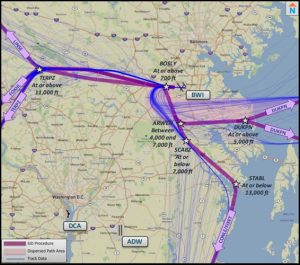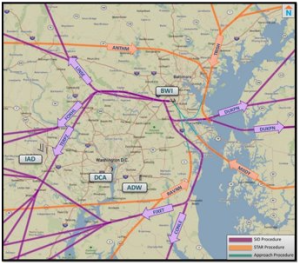On July 11th, 2024, FAA published new Performance Based Navigation (PBN) departure procedures out of BWI Marshall Airport. The departure procedures are part of changes that have been under consideration since 2018. The FAA intends to publish new arrival and approach procedures in September 2024.
In 2014 the FAA began to roll out a number of performance-based navigation (PBN) procedures for aircraft arriving and departing BWI Marshall Airport, otherwise known as NextGen. These procedures use satellite technology to provide more precise positional information to the pilot and air traffic controllers, increasing the margin of safety and efficiency of the airspace. The implementation of these procedures led to a considerable increase in noise complaints and community input. As a result, the Maryland Aviation Administration (MAA), at the request of the Federal Aviation Administration (FAA) formed a community roundtable, the DC Metroplex BWI Community Roundtable, comprised of community and aviation industry members. The Community Roundtable has met continuously since 2017 and has worked tirelessly to effect change.
The MAA working with its consultants and the Roundtable technical committee, completed an analysis of the arrival and departure procedures that had been implemented by the FAA. During the analysis period the FAA proposed updated departure procedures that the MAA and Roundtable reviewed and found acceptable. One of the goals of the Roundtable was to move flight tracks back to pre-NextGen dispersion levels. While this was not possible, the FAA proposed adding a new departure procedure which, when included with the other departure procedures, will provide for some level of dispersion.
These updates mainly affect flights heading west out of BWI Marshall and overflying Howard County. The main Standard Instrument Departure Procedure (SID) used out of BWI Marshall for aircraft heading west is the TERPZ SID. The TERPZ SID, which has shifted south of its current route from Runway 28 to return aircraft flight paths closer to pre-Metroplex historical locations, is expected to be utilized 74% of the time with the LINSE SID being utilized the remaining 26% of the time.
- The LINSE SID will move aircraft further south of the TERPZ SID thus providing some dispersion of flights along those flight paths, and better distribute departures over pre-Metroplex historical locations.
- The DUKPN SID replaces the conventional procedures PALEO and SWANN, which serve aircraft departures to the northeast.
- The CONLE and FIXIT procedures, which serve aircraft departures to the south, have been adjusted to meet FAA design criteria.

Additionally, the MAA and the Roundtable proposed updated arrival and approach procedures to the FAA for aircraft arriving at BWI Marshall. In November of 2019 the Roundtable reviewed a noise and technical analysis of the proposed arrival and approach procedure changes and favorably voted to submit the proposed procedure changes to the FAA. Those procedures were successfully submitted to the FAA and after a through review by the FAA are set to be implemented September 5, 2024. The anticipated benefits of the procedure changes include: increased higher aircraft altitudes on arrival and approach, fewer instances of aircraft flying large distances to the airport at lower altitudes, reduced/near-idle engine power settings do to continuous descents, better distribution of approach operations and the relocation of flight paths with the potential to reduce cumulative community noise exposure.
On September 5, 2024, FAA published new Performance Based Navigation (PBN) arrival procedures into BWI Marshall Airport. The MAA and the Roundtable proposed updated arrival and approach procedures to the FAA for aircraft arriving at BWI Marshall. In November of 2019 the Roundtable reviewed a noise and technical analysis of the proposed arrival and approach procedure changes and favorably voted to submit the proposed procedure changes to the FAA, followed by the development of additional changes to arrival procedures. Those procedures were successfully submitted to the FAA and after a thorough review and some revisions by the FAA, are now implemented as of September 5, 2024.
The anticipated benefits of the procedure changes include: increased higher aircraft altitudes on arrival and approach, fewer instances of aircraft flying large distances to the airport at lower altitudes, reduced/near-idle engine power settings due to continuous descents, better distribution of approach operations and the relocation of flight paths with the potential to reduce cumulative community noise exposure.
 More specifically, changes south of the airport for Runway 33L arrivals would:
More specifically, changes south of the airport for Runway 33L arrivals would:
- Shift RAVNN arrival aircraft northwest of current corridor over less densely populated areas
- Establish continuous descent RNAV and RNP approaches along corridors commonly used for visual approaches
- Better distribute approach operations along the final approach course by adding a third approach corridor to alleviate some traffic flying to the GRAFE navigational point
Changes west of the airport for Runway 10 arrivals would:
- Shift flight paths closer to the airport to reduce burden from western portions of Columbia
- Increase aircraft altitudes on arrival and approach
Changes north of the airport for runway 15R arrivals would:
- Increase the altitudes of some arrivals to Runway 15R
The FAA intends to implement these changes via updates to published RNAV STAR and Instrument Approach Procedures (IAPs), including the STARS ANTHM, TRISH, RAVNN, and MIDDY and various IAPs.

